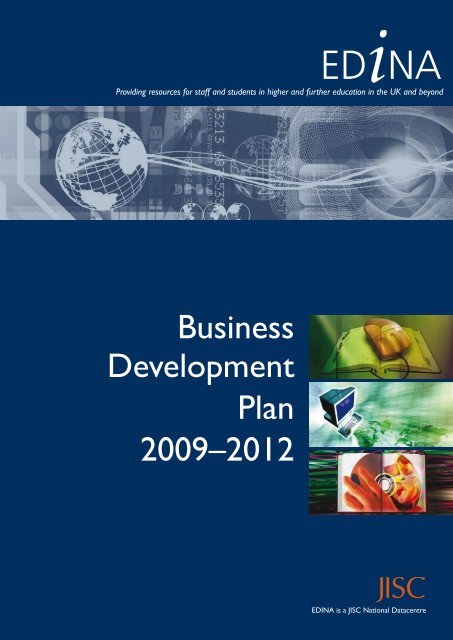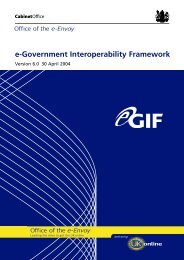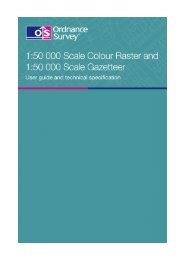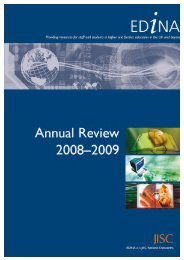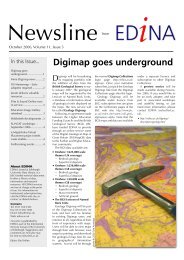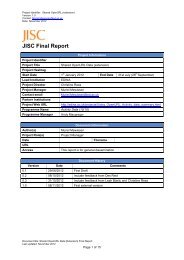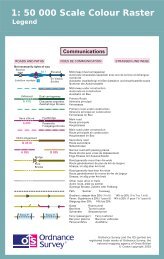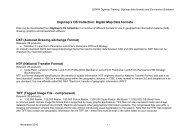Business Development Plan 2009â2012 - Edina
Business Development Plan 2009â2012 - Edina
Business Development Plan 2009â2012 - Edina
- No tags were found...
You also want an ePaper? Increase the reach of your titles
YUMPU automatically turns print PDFs into web optimized ePapers that Google loves.
Providing resources for staff and students in higher and further education in the UK and beyond<strong>Business</strong><strong>Development</strong><strong>Plan</strong>2009–2012EDINA is a JISC National Datacentre
Table of Contents1. INTRODUCTION ......................................................................12. MISSION ............................................................................13. VALUES ............................................................................14. CONTEXT ............................................................................15. BUSINESS PLAN FOR 2009–2012 ........................................................3Strategic goal 1: .........................................................................3To provide added value, high quality services, leveraged by research, enhancement activity and engagementwith othersStrategic theme 1a: ....................................................................3-7Providing a managed portfolio of added value, high quality servicesStrategic theme 1b: ...................................................................8-11Shaping the future and gaining understanding by undertaking innovative R&D projectsStrategic theme 1c: ...................................................................12-13Gaining leverage through national and international engagementStrategic goal 2: ........................................................................14To enhance our resource base through staff talent, technology and effective management of resourcesStrategic theme 2a: ..................................................................14-15Recruiting, retaining and developing a flexible complement of skilled staff, capitalising on reputation, ‘knowhow’and partnershipsStrategic theme 2b: ..................................................................16-17Developing and maintaining outstanding IT capabilityStrategic theme 2c: ..................................................................18-19Providing effective governance and management of resourcesStrategic goal 3: ........................................................................20To sustain and develop a well-founded UK national academic data centreStrategic theme 3a: ..................................................................20-21Securing sufficient funding to meet strategic goals in the medium- to long-termStrategic theme 3b: .....................................................................22Managing appropriately financial and legal liabilitiesStrategic theme 3c: . . . . . . . . . . . . . . . . . . . . . . . . . . . . . . . . . . . . . . . . . . . . . . . . . . . . . . . . . . . . . . . . . . . . . 23Ensuring EDINA’s long-term sustainabilityAPPENDIX ONE: STRATEGIC DIMENSIONS. ..................................................i
EDINA <strong>Business</strong> <strong>Development</strong> <strong>Plan</strong> 2009–2012EDINA <strong>Business</strong> <strong>Development</strong> <strong>Plan</strong> 2009–2012Providing resources for staff and students in higher and further educationin the UK and beyond1. IntroductionThis is EDINA’s <strong>Business</strong> <strong>Development</strong> <strong>Plan</strong> for 2009-2012. It is being published alongside theEDINA Strategy for 2009-2012 and provides our plans for delivery on the strategic goals we have setourselves. You can see more about what we do at our website, http://edina.ac.uk . EDINA welcomesyour feedback on our plans by email (edina@ed.ac.uk), by telephone (0131 650 3302) or by othermeans of social networking.2. MissionEDINA seeks to enhance the productivity of research, learning and teaching, in the UK and beyond.EDINA is a UK national academic data centre, designated by JISC on behalf of UK funding bodies tosupport the activity of universities, colleges and research institutes in the UK, by delivering continuingaccess to a range of online data services through ‘network-level’ infrastructure, as well as supportingknowledge exchange and ICT capacity building, nationally and internationally.3. ValuesWe value:• Excellence in our own work and the work of others, especially those we serve• Knowledge and Understanding in service delivery and research work• Engagement with our users and partners, nationally and internationally• Enhancement gained from talent and technology• Enthusiasm in what we do4. ContextBased at the University of Edinburgh, EDINA is a national provider of online data services, workingclosely with its sister data centre Mimas, which is based at the University of Manchester. The growingnumber of projects that EDINA carries out, sometimes in partnership, help to define how we canadd value by preparing new services and assisting JISC in the development of interoperability acrossservices, especially in the Integrated Information Environment (IIE).EDINA is an integral part of the academic information landscape in the UK, taking a lead in creatingand developing services essential for research and teaching that are on the whole not provided bycommercial players. It delivers a wide range of cost-effective online services which are free at thepoint of use, some specialist in nature and some requiring institutional subscription,.Well-established and successful in its role as a national academic data centre, EDINA is now a‘HEFCE-related Body’, the subject of a Funding Agreement between the University of Edinburgh andthe Higher Education Funding Council for England (HEFCE), acting on behalf of all the Higher andFurther Education funding councils in the UK.1
EDINA <strong>Business</strong> <strong>Development</strong> <strong>Plan</strong> 2009–20125. <strong>Business</strong> <strong>Plan</strong> for 2009-2012Strategic goal 1:To provide added value, high quality services, leveraged by research, enhancement activity andengagement with others.This drives EDINA’s activity locally, nationally and internationally; and its value proposition to ourstakeholders and users.We identify three key strategic activities or themes:a. Providing a managed portfolio of added value, high quality services [the near term];b. Shaping the future, gaining understanding by undertaking innovative R&D projects;c. Gaining leverage through national and international engagement.Strategic theme 1a:Providing a managed portfolio of added value, high quality servicesSummary of activity:EDINA provides national online services primarily, but not entirely, to UK H/FE staff and students, andResearch Councils 1 . These services fall into the following categories:• Services on licensed content for designated communities, usually licensed by JISC Collections foruse by the F/HE community and Research Councils in the UK, but also supplied by other providers• Repositories of community-generated content• Services on open access to all• Access management and middleware 2 services• Preservation services• Knowledge exchangeSome services require institutional subscription and others are on open access; all are free at the pointof use. Most services use methods of access management supported by the UK Federation for AccessManagement.EDINA seeks to ensure that end users receive quality services, in terms of the online and addedvalue experiences offered, along with reliability, responsiveness and support; and aims to improveengagement with the community to ensure that services meet the needs of users and respond morequickly to changing requirements.EDINA’s reputation for high quality support for use of services and data is a key factor in the successof its services. This applies particularly to services which require some specialist knowledge andthose for which local support is difficult to find. Availability of in-house expert institutional support isreducing, due to the financial pressures placed upon institutions. Yet this comes at a time when thereis increase in the use of geospatial and other more complex data by the academic community.1. See http://edina.ac.uk for a full record of services provided2. See http://www.jisc.ac.uk/whatwedo/programmes/middleware/team.aspx for definition of middleware3
EDINA <strong>Business</strong> <strong>Development</strong> <strong>Plan</strong> 2009–2012Objectives for 2009-2012:Provide high quality outreach and support servicesfor contributors, end users and support staffEnhance content, presentation and delivery ofservices in response to community requirementsWe shall achieve these objectives by:• Meeting targets for service provision laid down in our Service LevelAgreements (SLA) with JISC.• Continuing to provide high quality helpdesk, training, promotional andsupport services to our communities, and maintaining our excellentreputation.• Investigating the provision of a specialist geospatial advisory servicethat would provide expert support to F/HEIs.• Increasing the number of ways in which we provide virtual assistanceto our users e.g. making appropriate use of social media tools, blogs,wikis, RSS feeds and Web 2.0 services.• Building and supporting active ‘self-help’ communities within ourstrategic business areas.• Producing a range of online learning materials using content fromEDINA services and making them available to the community via theL&T repository and the EDINA website.• Adding commissioned materials to the multimedia, educational andgeospatial services to assist teachers and researchers.• Providing support as required for new communities.• Working with JISC Digital Media (formerly TASI) to support growingmultimedia use in education.• Implementing technical improvements in services, as required, toenhance their performance, speed or resilience.• Simplifying metadata schemas where possible.• Undertaking a scoping study into the mobile internet and deliveryof services for students and researchers, starting with the geospatialservices.• Adding personalisation functionality to the geospatial and multimediaservices.• Improving interfaces for support staff in the scholarly communicationsservices.• Developing 3D visualisation tools for geospatial services.• Undertaking investigations into mechanisms by which users can viewtheir own geospatial data within the mapping applications and sharedata with others to enhance the user experience.• Keeping a watching brief on mechanisms for user rating and reviewing/commenting in the geospatial and multimedia services.• Investigating the exploitation of geographic referencing in multimediaservices.• Keeping a watching brief on streaming and webcasting in themultimedia services.• Undertaking contributor audits in L&T and scholarly communicationsservices.• Continuing to undertake user requirements and interface testingwork with our communities, in order to inform enhancements.• Providing opportunities for groups of users to meet both virtually andface-to-face and provide feedback to EDINA e.g. in forums and usergroups.• Taking opportunities to bid for small sums of funding that allow us toengage with our users and find out their requirements.• Working with the JIBS User Group to obtain feedback from users ofour services.6
EDINA <strong>Business</strong> <strong>Development</strong> <strong>Plan</strong> 2009–2012Strategic theme 1b:Shaping the future and gaining understanding by undertaking innovative R&D projectsSummary of activity:EDINA exists to add value to the work of our communities by developing and delivering commonservices at the ‘network-level’. Determining what adds value and how we can arrive at the position todeliver takes investment in understanding. By undertaking innovative R&D work, EDINA seeks to gainthat understanding and play our part in shaping the future.There are several ways in which R&D takes place via different funding streams:1. Project activities, arising from JISC and other funding streams as a result of bidding or directedactivity.2. Service enhancement projects, funded by JISC;3. Proto-service activities, often machine-to-machine (M2M) middleware activities;4. Service-in-development activities, funded by JISC, in which the activities function as if they wereservices, often for projects with JISC Innovations Programme [strong elements of R&D, no ServiceLevel Agreements (SLAs)]. The latter are in the development roadmap;5. ‘Watch’ activities, often undertaken as work packages within projects, in order to ensure continuedunderstanding of the technical and cultural landscapes in which the project is working.R&D activities form part of EDINA’s three-year rolling business development plans, to ensure thatactivity undertaken fits within the strategic directions of the data centre. The importance of thisactivity can be seen from the close relationship between innovation, project activity and transitioninto service. EDINA engages in influential scoping activity to inform the community, builds and testspioneering facilities, is given charge of key ‘services-in-development’ and runs the resulting services toService Level Agreements.One example of project-to service activity is the Digimap Collection, which started as a e-Lib projectin the late 1990s, progressed to service, and now stands as an internationally-recognised flagshipservice, supporting not only several data collections, but also activity to establish the UK and Europeanspatial data infrastructure.The Jorum and SUNCAT had different project beginnings but are both hybrid services-indevelopment,and have comparable prospects with regard to establishing e-infrastructure respectivelyfor e-learning and scholarly communication; Jorum acting as a means of distribution for L&T materialsgenerated by the UK academic community, and SUNCAT playing a pivotal role in access to documentdelivery and related services.8
EDINA <strong>Business</strong> <strong>Development</strong> <strong>Plan</strong> 2009–2012In L&T, R&D areas in which we will work with Mimas over the period covered by this strategy include:• Offering structured support to beginners and others in creating, sharing and reusing digital L&Tmaterials: we will provide a ‘Community Bay’ of tools, materials and social networking mechanismsto support contributors in sharing their learning materials.• Scoping additional services: developing viable business models for a range of services that could beoffered under the Jorum banner.• Expanding the licensing model: developing viable licensing models for a range of possible services.• Providing a proposal for an archive service: working with the ULCC to determine what would bethe characteristics of L&T materials that would require long-term preservation and how to makesuch a service available.R&D in the Access Management area will include:• Inter-Federation working: developing protocols to allow metadata interchange between federations,so that members of one federation can access resources within another federation.• Testing deployment of Shibboleth project deliverables and their compatibility with new releases ofkey platform environments: ongoing R&D for EDINA.• Federation operations development: including replacing the UK Federation Discovery Service;instituting new procedures for schools; and revision of tools and procedures for Shibboleth 2.x.• Quick IdP installer: following the successful release of the QuickIdP installer for Shibboleth 1.3 in2008, the EDINA Access Management Expert Group will release a corresponding product forShibboleth 2.x. Quick IdP software lowers the barriers for institutions implementing their ownIdPs within the UK Federation.• SPNEGO: we will undertake research into using the SPNEGO protocol.EDINA also has several areas of cross-service R&D activity that will continue during the time coveredby this <strong>Plan</strong>. They are:• Mobile Internet: monitoring on a cross-service basis the fast-moving developments in this area,sharing expertise across EDINA and undertaking relevant work.• Repositories and preservation: keeping a ‘watch’ in this area, share expertise and undertakerelevant work.• Techwatch: this group monitors new technical developments and trends and agrees browser/environment testing for services.• Virtual Research Environments (VRE): EDINA participates on a cross-service basis in a JISCfundedproject, which is providing support to the JISC VRE Programme, helping to identify suitablesolutions for the interoperability of VRE tools, applications, and resources.10
EDINA <strong>Business</strong> <strong>Development</strong> <strong>Plan</strong> 2009–2012Objectives for 2009-2012:Build capacity in EDINA, including strategiccapabilities, in each of our business areasWe shall achieve these objectives by:• Continuing the activities in our SBAs, examples of which are givenabove (pages 11–13).• Adding new capabilities as appropriate.Transition appropriate R&D projects to services • At the outset of projects, identifying where they may have potentialservice exit strategies.• Devising a framework for project-to-service transition.• Developing critical appraisal of R&D activity, standing down projectsas appropriate.Respond to opportunities to undertake R&DprojectsIdentify and create opportunities to undertakeinnovative work that fits within strategic goals• Responding to invitations to tender.• Monitoring relevant mailing lists, websites etc.• Attending conferences and other events.• Monitoring news services and newspapers.• Keeping in touch with JISC Programme Managers.• Ensuring that existing projects and services-in-developmentundertake ‘watch’ activities on the technical and culturalenvironments that influence them.• Where opportunities arise from existing work, ensuring that thepotential for new innovative work is explored with funding bodies.• Establishing links with new content providers, and with innovators.11
EDINA <strong>Business</strong> <strong>Development</strong> <strong>Plan</strong> 2009–2012Strategic theme 1c:Gaining leverage through national and international engagementSummary of activity:EDINA works at local, national and international levels in each of its strategic business areas(SBAs), engaging in initiatives that assist productivity in research, learning and teaching. We plan tofurther develop our links with important national and international groups, including governmental,educational, standards development, research data, commercial, web services and grid developmentorganisations. Some of the JISC’s key strategic targets are expressed in contacts between EDINAand these organisations, and achieved in the joint work undertaken, for example, internationalcollaboration to develop the E-Framework for Education and Research. In addition, Research Counciland EU activities in which EDINA is engaged give a focus to collaboration and synergy. Our nationaland international contacts are also important for the University of Edinburgh’s strategic aims as aworld-class University seeking to enhance its global presence.As a JISC-funded centre, EDINA will continue to engage closely with other JISC-funded centres andinitiatives and with academic support staff in HE and FE institutions. Developing further links withResearch Council staff is one of the aims of this plan. We will also engage with the researchers,teachers and students who are our customers, often via their local support staff, but also directly inour helpdesk and support services, training events and user requirements work.All of EDINA’s service areas will continue to work with intermediaries providing services to the samecommunities to leverage training, promotional and support activities.Some of our geospatial activities are world-class and especially important as the scientific communityprepares to implement the INSPIRE-led European Spatial Data Infrastructure (SDI). This is leading toproductive partnerships between EDINA and European organisations in the academic, commercialand governmental sectors seeking to implement the directive. We will continue to participate ininternational standards development, in Scottish initiatives for interoperability and data sharing, and ine-Science initiatives.Scholarly communications work in EDINA has close links with the major national and specialistlibraries, as well as libraries from some of the largest HE institutions in the UK. We also have fruitfulrelationships with academic and commercial partners, standards organisations, union catalogues ofserials, especially across Europe, and international networks, particularly in the Open Access arena,which we shall continue to develop.In addition, we will have active commitment and responsibility for continuing access to the growingcorpus of scholarly resources in digital format, with the University acting as the European archive nodefor the CLOCKSS digital preservation of e-journal content.We work in partnership (with Mimas) to deliver the JISC’s national repository of learning and teachingmaterials, which will be developed into an Open Educational Resources (OER) repository during thetime covered in this plan. We shall continue to work with various JISC-funded services and a varietyof intermediaries to deliver services and engage with the community in the UK. Internationally, we willdevelop further our links with other key national repository services and with governmental bodiesand standards development organisations.12
EDINA <strong>Business</strong> <strong>Development</strong> <strong>Plan</strong> 2009–2012EDINA will continue to build on and develop its relationships with key players in the multimediaindustry in the UK and with JISC-supported organisations, in order to ensure that our multimediaservices are relevant, distinctive and add value to JISC-funded subscription services.We will continue to work closely with colleagues in the UK in the ongoing development of the UKFederation for Access Management; with the core developers in the Internet2/MACE committeeto develop the base standards, protocols and core software; and with international adopters ofShibboleth technology. We have contact with the national federations in the USA, Switzerland,Finland, Australia, France, Norway, Sweden and Denmark.EDINA plans to build on its excellent reputation locally, nationally and internationally by engaging inappropriate initiatives and working with existing and new partners. In addition, we shall continue toinvite distinguished people working in important strategic areas to visit and speak with our staff.Objectives for 2009-2012:Highlight gaps and opportunities in existing nationaland international engagementWe shall achieve these objectives by:• Undertaking an audit of national and international relationships.• Highlighting gaps and opportunities and using the information tomake contacts.Consolidate and improve existing collaborations • Continuing to work closely with our sister data centre, Mimas, andwith JISC-funded and other UK centres and initiatives.• Assisting member states prepare and test their data for theINSPIRE-led European Spatial Data Infrastructure.• Participating with partners in Australia and New Zealand on thedevelopment of the E-Framework.• Taking every opportunity to improve and build on existingcollaborations, to maintain relationships and apply for new funding.Build new partnerships and collaborations • Taking opportunities to network and build new potentialpartnerships in advance of funding opportunities becoming available.• Maintaining a watch in each strategic business area for potentialpartners and acting on opportunities.13
EDINA <strong>Business</strong> <strong>Development</strong> <strong>Plan</strong> 2009–2012Strategic goal 2:To enhance our resource base through staff talent, technology and effective management ofresources.This goal summarises the second strategic area in which EDINA seeks sustainability, namely Resourcesand Context, the aim of which is to maximise the return on the tangible and intangible assets of thedata centre, especially the reputation and ‘know-how’ of staff.Within this overall goal, we have identified three strategic themes:a. Recruiting, retaining and developing a flexible component of skilled staff, capitalizing on reputation,‘know-how’ and partnershipsb. Developing and maintaining outstanding IT capabilityc. Providing effective governance and management of resourcesStrategic theme 2a:Recruiting, retaining and developing a flexible complement of skilled staff, capitalising on reputation, ‘knowhow’and partnershipsSummary of activity:Staff development and retention are at the forefront of EDINA’s strategic plan. As a knowledgeorganisation, staff and their ‘know-how’, expertise and skills remain our greatest asset. Our Directorhas written, “We value staff of talent, skill and motivation as our most important resource”. Bycontinuing to extend the skills and knowledge of staff and by providing a challenging and rewardingworking environment, we will allow the organisation to develop further and to continue providingvaluable services to our stakeholders.EDINA aims to recruit, retain and develop a flexible complement of able, skilled and well-motivatedstaff by providing staff development opportunities and attractive, appropriate terms and conditions.EDINA is committed to the principles of opportunity, equality and diversity, with recruitment of staffbased on merit and ability.A staff development plan for each member of staff is agreed annually and discussed between the staffmember and his/her line manager. EDINA staff have the opportunity to participate in training eventsorganised by IS and other groups within the University, as well as external training and developmentopportunities.EDINA aims to be an attractive place for people to work, a place where individuals feel empoweredto succeed in their role, their success is recognised, and they have the opportunity to achieve a goodwork-life balance.EDINA aims to ensure that cross-fertilisation of ideas and ‘know-how’ takes place in the data centre,by means of regular workshops and meetings in which staff can share their knowledge, and byprovision of online tools such as the staff intranet. In addition, EDINA aims to share and exchangeknowledge with partners in the UK and in the outside world. This allows us to learn from others, aswell as contributing to their learning, and builds expertise and capacity.14
EDINA <strong>Business</strong> <strong>Development</strong> <strong>Plan</strong> 2009–2012Objectives for 2009-2012:Provide staff with equitable opportunities for theirdevelopment, in line with University guidelines andwithin staff development resources availableEmpower staff to perform and succeed in theirroles and recognise their successBuild capability by sharing and exchanging ‘knowhow’across the data centre, within InformationServices and the University, with key partners suchas Mimas and other JISC services, and with theoutside worldContinue to bring in and retain able, committedstaffWe shall achieve these objectives by:• Agreeing a staff development plan annually with each memberof staff.• Agreeing a policy for ensuring that staff members receiveequitable treatment in obtaining development opportunities.• Making available to staff internal and external opportunities fortraining, self-development and preparation for leadership roles.• Staff with management roles to participate in the University’sLeadership and Management Framework in the University.• Recognising and rewarding staff through the University’sContribution Reward scheme.• Ensuring that staff members receive positive reinforcement interms of praise and encouragement from managers.• Empowering staff through delegation of responsibility andinvolvement in decision-making.• Encouraging and supporting staff to help one another.• Appointing a support officer to provide office system supportand be responsible for shared equipment.• Encouraging staff to use the intranet.• As required, establishing cross-service groups to share andexchange knowledge about common areas across EDINA.• Keeping under review methods of sharing knowledge e.g. themonthly staff meeting.• Participating in IS knowledge sharing activities.• Considering holding joint Management Board and ManagementTeam meetings between EDINA and Mimas.• Undertaking more projects with Mimas and other JISC services.• Continuing to foster engagement with partners and potentialpartners around the world, and participate in national andinternational conferences and events.• Keeping under review our recruitment methods and practices.• Ensuring that we promote equality and diversity in ourworkplace.• Working with the University on grading structures to try toenhance promotion prospects for staff.• Supporting staff with special needs.• Maintaining flexibility in our working practices.• Ensuring that staff members know about and benefit fromUniversity policies such as family leave.15
EDINA <strong>Business</strong> <strong>Development</strong> <strong>Plan</strong> 2009–2012Strategic theme 2b:Developing and maintaining outstanding IT capabilitySummary of activity:EDINA aims to develop and maintain exceptional IT capability, by engaging in ‘technology watch’ andthereby remaining relevant to the community; and by commanding sufficient resources, in terms ofhuman skills, software and hardware, for planning and deployment.EDINA hardware strategy has been, and will remain, focused on providing flexibility, reliability andperformance across the full range of service requirements. There is now agreement with JISC for arecurrent hardware funding model and funding is now in place for the period 2008-2011.EDINA will sustain the considerable synergy and gain from its position inside the University ofEdinburgh, and its compatibility with the University’s ICT strategy. The general strategy is to continuemigration away from locally attached storage to using a Storage Array Network (SAN) in partnershipwith the University. This means that storage arrays are network attached via fibre switches to multiplehosts and means that EDINA gains leverage from the much larger investment by the University inthis technology. We have continued a move towards virtualisation architectures, including Solariscontainers.The University of Edinburgh has established a twin-site configuration for backup, with a secondmachine room situated at a remote site several miles distant. EDINA has bought a fixed number of‘slots’ in the new SAN-based backup infrastructure purchased by the University, and the necessityfor operator intervention has been removed. Future additions to backup capacity can be made whennecessary by buying additional ‘slots’ in the University’s infrastructure. Additional machine room spaceat our remote site is due to be completed in July 2009. We intend to begin implementation of dualsite resilience for EDINA services once the second site is available. We also intend to provide aseparate hardware development environment for EDINA services. This will increase resilience andallow development to be conducted in an environment which is both more standardised and morecompatible with the production environment.EDINA is planning for major risks and business continuity in its IT infrastructure, with responses tovarious categories of events. Over the last year, we have improved resilience by converting andupgrading all of our servers to dual Gigabit connections configured for automatic failover. An extraGigabit network switch has also been deployed so that network connections are dual-pathed.In common with the University’s Information Services group, EDINA is utilising the ITIL IT ServiceManagement framework to ensure that we improve our IT services in line with best practiceprocesses. Several of our staff have attended University-arranged courses.EDINA reviews software systems used across the data centre, with a view to ensuring efficient andeffective use of software. We will continue to monitor open source solutions and offerings fromcommercial software vendors to ensure that the most effective options are deployed in EDINAservices. As web services are increasingly being supported by desktop tools, there is an increasingrequirement to provide our existing services via a combination of current and new access routes. Weplan to provide support for production web services. Our hardware and software infrastructure willneed to be able to accommodate the corresponding growth in demand.EDINA will continue to build on and develop its relationships with key players in the multimediaindustry in the UK and with JISC-supported organisations, in order to ensure that our multimediaservices are relevant, distinctive and add value to JISC-funded subscription services.16
EDINA <strong>Business</strong> <strong>Development</strong> <strong>Plan</strong> 2009–2012We will continue to work closely with colleagues in the UK in the ongoing development of the UKFederation for Access Management; with the core developers in the Internet2/MACE committeeto develop the base standards, protocols and core software; and with international adopters ofShibboleth technology. We have contact with the national federations in the USA, Switzerland,Finland, Australia, France, Norway, Sweden and Denmark.EDINA plans to build on its excellent reputation locally, nationally and internationally by engaging inappropriate initiatives and working with existing and new partners. In addition, we shall continue toinvite distinguished people working in important strategic areas to visit and speak with our staff.Objectives for 2009-2012:Maintain and continue to effect a rolling plan ofhardware upgrade and replacement to fulfil currentand future service requirementsImprove service resilience and ensure businesscontinuityMaintain a coherent and effective softwarestrategyWe shall achieve these objectives by:• Maintaining three-year rolling hardware strategies and update themannually, purchasing new or upgrade hardware as required.• Exploiting improvements in hardware technology and performancewhere cost effective.• Increasing processor and memory capacity to meet performance andscalability challenges of increasing service and service developmentneeds.• Using SAN storage to reliably accommodate increasing datavolumes.• Exploiting backup infrastructure capable of handling the increasingdata volumes within appropriate backup windows.• Ensuring network infrastructure sufficient to handle the requireddata volumes.• Implementing dual site resilience for key services.• Funding additional facilities management effort from the UniversityComputing Service.• Improving active service monitoring tools.• Reviewing the resilience of services.• Providing standby provision of key services at a remote location.• Ensuring the availability of sufficient trained staff to facility manageEDINA hardware.• Consolidating services using visualisation techniques.• Reviewing annually the IT components of the detailed risk register.• Revising IT disaster recovery plan and emergency management plan.• Testing selected components of the IT disaster recovery plan toensure the plan’s effectiveness.• Reviewing annually the software systems and methodologies in useacross EDINA.• Selecting software appropriate to specific tasks.• Employing effective design, build and control methodologies.• Utilising software that is compatible with the strengths of EDINAstaff.• Recognising the benefits of adopting open system software andstandards where appropriate.17
EDINA <strong>Business</strong> <strong>Development</strong> <strong>Plan</strong> 2009–2012Strategic theme 2c:Providing effective governance and management of resourcesSummary of activity:EDINA operates as a HEFCE-related body under the terms of a Funding Agreement signed betweenHEFCE and the University of Edinburgh. A Management Board has been established under the termsof the Agreement that offers specialist advice and guidance. The Director of EDINA reports to theBoard. The Chair is chosen in agreement between the University and JISC. Membership includesrepresentatives from the JISC Secretariat, the user community, the Director of EDINA, and theUniversity of Edinburgh.The Director of EDINA is an employee of the University of Edinburgh and is responsible to the VicePrincipal and Chief Information Officer of the University; the latter sits on the EDINA ManagementBoard. The Director of EDINA sits on the Information Services (IS) Executive.The EDINA Management Team meets fortnightly and is responsible for leadership of activity, financeand resource planning in the data centre.The <strong>Business</strong> <strong>Development</strong> Group guides the development of new project and service activity withinEDINA and meets fortnightly.EDINA aims to provide a clean, tidy, efficient, organised, well-maintained professional workingenvironment for all staff. The move to commercial premises in Edinburgh has improved the workingenvironment and provided additional resources to staff, such as a number of meeting rooms that anymember of staff can reserve.Constraints on EDINA’s growth in past years caused by accommodation were eased by the moveto commercial premises, but there soon became a requirement to provide extra accommodationto resource activities. Additional accommodation has been secured on another floor in the samebuilding and some staff will be moved to the new location in early 2009. It is anticipated that theadditional accommodation will address for the duration of this plan the constraints previously faced bythe organisation due to lack of accommodation for staff.EDINA’s office at St Helens College in Newton-le-Willows, Merseyside, will be moving, due to theplanned closure of the campus by the College. It is likely that the staff will move to commercialpremises in Cheshire during 2009.EDINA has made a small investment in ‘corporate positions’, beginning with additional managementeffort. Some additional posts will be advertised in the 2008-2009 year, made possible by theadditional accommodation at Edinburgh.The strategic intention is to facilitate growth where necessary, but to ensure that growth will becontrolled through strategic partnership arrangements and outsourcing where applicable. Priority isbeing given to improving methods of projecting income, activity and hence staffing and accommodationrequirements.In common with many other organisations that receive much of their funding from grant money,EDINA faces challenges in being able to react quickly to opportunities when staff members arealready fully committed in their current work.18
EDINA <strong>Business</strong> <strong>Development</strong> <strong>Plan</strong> 2009–2012EDINA’s Strategy and the rolling business development plans in each of EDINA’s SBAs will addressthe whole of the activity undertaken by the data centre, and not just its JISC-funded activity. ServiceImplementation <strong>Plan</strong>s for JISC-funded activity will be guided by these documents. The annualOperational <strong>Plan</strong> for JISC will be based on the Service Implementation <strong>Plan</strong>s.EDINA contributes to the University’s IS Strategy <strong>Plan</strong>s, Annual <strong>Plan</strong>s and Annual Reports under theheading of “National and International Engagement”.EDINA is currently working on improving our management accounting systems to make betterinformed business decisions.Objectives for 2009-2012:Work within our governance structure todemonstrate effective management of resourcesto our key stakeholdersImprove methods of projecting activity andincome, and hence staffing and accommodationrequirementsEnsure that any funding opportunities that ariseare considered in line with strategic goals, and thatresources are made available to undertake theworkEnsure that we make better informed businessdecisionsRemove constraints on staffing caused by lack ofsuitable accommodationWe shall achieve these objectives by:• <strong>Plan</strong>ning and reporting as required to the IS and the University, theJISC and the EDINA Management Board.• Using the business development plans to project activity and income.• Using these estimates to derive staffing and accommodationrequirements.• Working on a framework to make it easier for EDINA to reactquickly to opportunities.• Improving our management accounting systems• Providing additional accommodation.19
EDINA <strong>Business</strong> <strong>Development</strong> <strong>Plan</strong> 2009–2012Strategic goal 3:To sustain and develop a well-founded UK national academic data centreThis goal summarises the third area in which EDINA seeks sustainability; namely, Finances andLiabilities, the aim of which is to sustain and develop a well-founded UK national academic data centre.Within this overall goal, we have identified three strategic themes:a. Securing sufficient funding to meet strategic goals in the medium- to long-termb. Managing appropriately financial and legal liabilitiesc. Ensuring EDINA’s long-term sustainability.Strategic theme 3a:Securing sufficient funding to meet strategic goals in the medium- to long-termSummary of activity:Strategic financial concerns for EDINA are:• Synergy with strategic objectives, and partnership building• Predictability and long-term funding considerations• Widening the funding base of the data centre to reduce riskEDINA seeks long-term sustainability in order to meet its strategic goals. The constraints faced arethose of its parent organisations: EDINA is not autonomous. Of course, this does not mean thatEDINA is constrained by funding opportunities arising only from the parent bodies. EDINA appliesfor and is in receipt of grants from other organisations, currently mainly the EU and the ESRC.The environment in which EDINA works is not predictable: it is fast-changing and sometimesturbulent. Opportunities to apply for funding may come along unexpectedly, although JISC is nowattempting to advise its communities about forthcoming grants. Resource management at the datacentre needs to be flexible enough to respond to project bidding opportunities that fit within ourstrategic directions, yet support the necessary continuity for service provision.EDINA will ensure that the exit strategies of projects undertaken with innovation funding from JISCor others are included in the business development plan for transfer to longer-term service fundingstreams, if applicable. We will work within the JISC development-to-service guidelines and developour own portfolio management procedures as mentioned earlier in this plan.The principal purpose of our business development plans is to work out what EDINA plans to do ineach SBA over the forthcoming three years, identify funding sources for the activities planned, andmonitor risks that could undermine the sustainability of the organisation. If the activities planned areservice enhancements, the funding required will be notified to JISC or other funding providers. If theactivities planned are innovative projects, sources of funding will be identified and approached, ormonitored for future opportunities.20
EDINA <strong>Business</strong> <strong>Development</strong> <strong>Plan</strong> 2009–2012As an internet organisation, there are areas of activity that are common to all of our SBAs. Examplesinclude interest in developing for the mobile internet and repositories/preservation. To address this,EDINA has set up several cross-service groups. It is essential to ensure that resources are secured toenable staff to work in these groups, as well as in their own areas of activity, as these groups have thepotential for making efficiency gains. EDINA will seek to find ways to ensure that cross-service groupsare funded and resourced properly.EDINA is now able to apply for JISC funding on the basis of full economic costing (FEC). It is animportant contributor to the finances of the Information Services group of the University andFEC funding has enabled the move to larger premises that enables growth in staff numbers to befacilitated.EDINA will continue to monitor the external environment for sources of funding that will enable thedata centre to widen the base of its funding; and will work with JISC and others where appropriate toprovide services for which JISC has discontinued its direct support, on an ongoing JISC-approved basis.At present, EDINA is not investigating net revenue generating schemes.Objectives for 2009-2012:<strong>Plan</strong> for the future and identify suitable sources offundingSeek out and take opportunities to bid for fundingfrom a range of sources if the activity potentiallyfunded is in line with strategic goalsEnsure that activity that crosses service boundariesis funded and resourcedIf possible, recover Full Economic Costs fromfundersWiden the funding base of the data centre toreduce riskWe shall achieve these objectives by:• Writing three-year rolling business development plans and identifyfunding sources for planned activity.• Actively seeking new sources of funding.• Bidding for work where the activity is in line with strategic goals.• Working out the resource required to contribute to cross-serviceactivities and including this in budget calculations.• Including FEC calculations in budgets wherever possible.• Seeking and taking opportunities to apply for funding outside our usualfunding stream.21
EDINA <strong>Business</strong> <strong>Development</strong> <strong>Plan</strong> 2009–2012EDINACausewayside House160 CausewaysideEdinburghScotlandUnited KingdomEH9 1PREmail: edina@ed.ac.ukPhone: +44 (0)131 650 3302Fax: +44 (0)131 650 3308II


